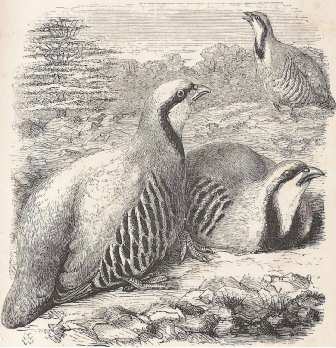|
|
The Partridge was
known in older English as the Pertriche, in Scottish as the Patrick,
in
Dutch is the
Patrijs, and in French Perdrix, all from the
Latin Perdix, which word in sound does not imitate badly the call-note
of this bird, So well known throughout the UK and the greater part or Europe.
The English name properly denotes the only species indigenous to Britain,
often nowadays called the Grey Partridge (to distinguish it from others,
of which more presently), the
Perdix perdix of ornithologists, also known as the Hungarian Partridge in the USA, a
species which may be regarded as the model game-bird - whether from the
excellence of the sport it affords in the field, or the no less excellence
of its flesh at table, which has been esteemed from the time of Martial
to our own - while it is on all hands admitted to be wholly innocuous,
and at times beneficial to the agriculturist. In India the name Grey
Partridge is used for Ortygornis ponticerianus
which is perhaps
a Francolin (rf. Jerdon, B. Ind. iii. p. 569).
The Partidge's Habitat
This bird thrives in
cultivated land, and the areas which are carefully tilled, and bear the
greatest quantity of grain and green crops, will generally produce the
greatest number of Partridges. The Partridge largely increased in
numbers in Great Britain from beginning of the 19th century until that
century's end, when so much down, heath and moorland was first brought
under the plough. However the Partridge population in the UK has reduced
by around 80% from the 1930s to the first decade of the 21st century, as
a result of highly intensive farming and cultivation of the land.
|

Picture of Greek Partridge
|
Appearance and Habits
of the Partridge
The partridge's partiality
to arable country is very evident. It has been observed that the birds
which live on grass lands or heather only are apt to be smaller and darker
in colour than the average; but in truth the species when adult is subject
to a much greater variation in plumage than is commonly supposed, and the
well-known chestnut horse-shoe mark, generally considered distinctive of
the cock, is very often absent (certain characters in the plumage can unfailingly
distinguish the two sexes of this species. In the adult cock the sides
of the neck are grey, but in the hen olive-brown, while nearly each feather
shows a buff shaft-stripe. Again the median upper wing-coverts in the cock
are of a sandy-brown blotched with chestnut and black transverse lines,
while in the hen the corresponding feathers are blackish-brown with conspicuons
buff crossbars).
It is a very active
bird, not taking to flight if it can escape by means of its legs, and,
itself, taking care to interpose, as it runs, stones or other obstacles
between itself and the object of its alarm. Similarly, the partridge
builds its nest on the ground rather than having to fly up into trees or
high areas.
The males, when they
think themselves unobserved, are fond of challenging, or calling to each
other in a loud ringing note.
|
|
Interesting types of
Partridge
In some parts of Asia
including china and the Philippines, the Bearded Partridge Perdix
barbata, can be found and in Tibet, the Tibetan
Partridge, Perdix hodgsoniae,
is a bird which lives on
the high mountain slopes, sometimes 4000 meters above sea level. The Red-legged
Partridge, found in Europe and Iberia, also known as the French
Partridge, Alectoris rufa, was brought to the UK around the
end of the 18th century, and is established particularly in Southern England.
Similarly to the grey Partidge, rather than fly, it often prefers to run,
although it can and will certainly fly if it decides this is the best option.
The French Partridge prefers a different habitat to the grey partridge,
the French bird preferring clay-type soil and generally more infertile
heathland, but even where the two species meet, the alleged antipathy between
them is imaginary, and unquestionably in certain parts of the UK the "head
of game" has been increased by the introduction of the "foreigner" (Game-preservers
who object most strongly to the Red-legged Partridge are often not agreed
on the exact grounds of their objection. One party will declare that it
vanquishes the Grey Partridge, while the other holds that, though the latter,
the "English" Partridge, is much vexed by the introduced species, it invariably
beats off the "Frenchman"!).
Then there is the
Greek Partridge, which is quite widely spread. It is a large bird
of its kind, being much larger than the Grey Partridge, and may be known
by its size, the dark red legs and beak, and the bold bars on the sides.
In North America
the "Partridge-Hawk" is not actually a partridge itself but
Accipiter gentilis (the Goshawk), and the"Partridge-Pigeon"
of Australia is a species of Geophaps (Bronze Wing).
|
|
|





